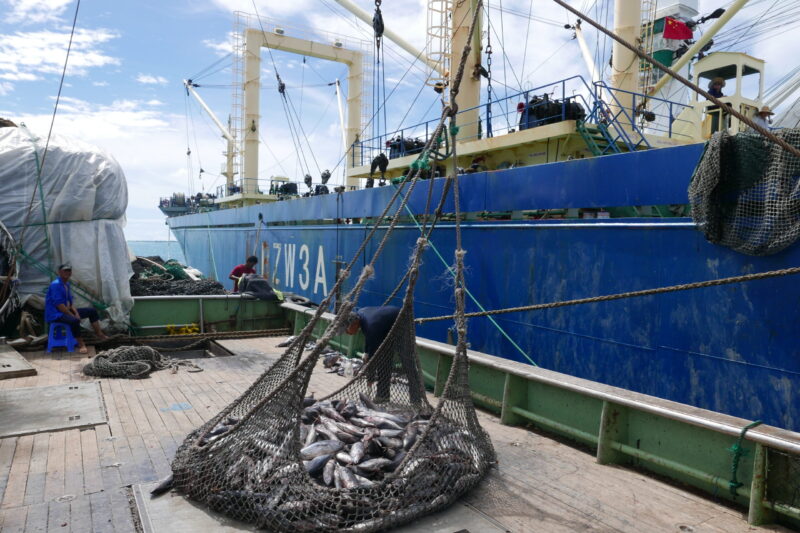Carrier Vessel Portal
About Global Fishing Watch Carrier Vessels
Transshipment is a vital part of the global fishing industry, but it often takes place far out at sea, making it challenging for authorities to determine whether the catch being transferred is both legal and verifiable.
To improve the understanding and management of transshipment, Global Fishing Watch partnered with The Pew Charitable Trusts to develop Global Fishing Watch Carrier Vessels, an innovative technology portal that harnesses transparency to bring greater monitoring and analysis of this activity to all those who need it, and for free. The two organizations developed the carrier vessel portal to help policymakers and fisheries managers better comprehend the activities of carrier vessels that take on catch from commercial fishing vessels and deliver it to ports worldwide for processing. The portal provides a valuable tool for managers that seek to verify transshipment activities, which can help reduce opportunities for unauthorized transfers of fish products and also identify when such activities are not being adequately reported.
The portal uses publicly available data from 2017 through the present (with 72 hours delay) to identify potential vessel encounters and loitering events. Updated with new registry data monthly, it synthesizes fishing registry information to create a picture of potential authorizations for both carrier and fishing vessels involved in transshipment activity.
As the first-of-its-kind comprehensive transshipment monitoring tool, the carrier vessel portal is utilizing vessel transparency to help inform management and policy efforts across the fishing sector.
How the portal works
The carrier vessel portal uses satellite technology, machine learning and up-to-date vessel databases to give users consolidated information on carrier vessels’ activities, allowing them to analyze vessel tracks and see which ports are most frequented.
- Automatic identification system, or AIS, data is used to display vessel tracks and estimate vessel activity, including possible transshipment. AIS transmits a ship’s location, speed, direction and identity information, such as its name and flag. By tracking the vessel’s movements, analysts can track where a vessel has gone and identify when vessels are potentially transshipping at sea or visiting a port.
- Vessel registry data is matched to the AIS data to identify the authorization of carrier and fishing vessels in the portal. Publicly accessible historical records and currently monthly records obtained from regional fisheries management organizations are used to identify if vessels were authorized during the time of potential transshipments.
- The portal relies on a carrier vessel database curated using a combination of sources including vessel registry lists, national registries, International Maritime Organization numbers, web and search images, as well as a machine learning algorithm used to estimate vessel class.
The carrier vessel portal can give policymakers from the five tuna regional fisheries management organizations (RFMOs)—responsible for managing fisheries in more than 90 percent of the world’s ocean—a better understanding of transshipment activities in their respective waters. Managers and authorities can use the portal to crosscheck AIS data and Republicly available registry records from overlapping RFMOs with vessel monitoring system data and the national and observer reports they already receive. By providing a clear history of a vessel’s fishing activity, the portal can help RFMOs effectively exchange information and ensure the catch and its transshipment are legal and correctly reported.
Proper management and oversight are needed to ensure traceability and transparency in transshipment. With the carrier vessel portal, we now have the power to arm policymakers with the information they need to improve monitoring and controls in one of the most hidden practices throughout the fishing industry. Free registration provides full access to the carrier vessel portal features, which include:
Free registration provides full access to the carrier vessel portal features, which include:
- Analysis of loitering events and encounters.
- Filtering of data by time, area of activity, flag State, port, event duration and vessel.
- Detailed vessel history of possible transshipment events mapped through time.
- Downloadable individual vessel history data, which includes loitering events, encounters and port visits.
